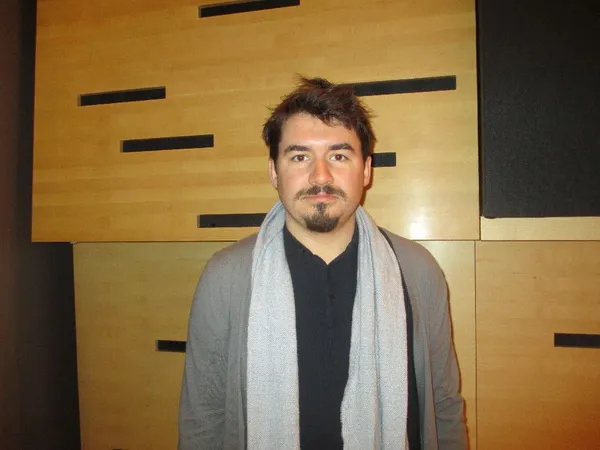 |
| Parabellum director Lukas Valenta Rinner: "A lot of people mention the connection to Austrian cinema like Ulrich Seidl for example." Photo: Anne-Katrin Titze |
"The world is no longer a predictable place," we hear in Parabellum as we follow the featureless man and a group of blindfolded tourists into a swamp delta for a survival training unlike any other. Lukas Valenta Rinner directs with confidence and a detached gaze the goings-on in the explorer's camp that offers courses on homemade explosives and the mandatory survival underwater training. John Huston's The African Queen and Benoît Jacquot's Farewell, My Queen are about two different kind of personal survival. Austrian parallels come into play with his New Directors/New Films colleagues, Goodnight Mommy directors, Veronika Franz, and Severin Fiala, as well as Michael Haneke and Ulrich Seidl. Pablo Seijo connected with his character through Michel Houellebecq's books.
The participants we hardly get to know in Parabellum because they don't talk to each other and never smile or laugh. Out of shape, pale, and of all ages, they could have been picked from any tour bus, anywhere in the world.
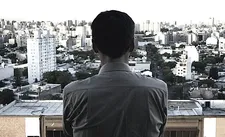 |
| "I get really inspired by locations." |
Anne-Katrin Titze: Parabellum captures a zeitgeist of dissatisfaction with what is going on in the world. There is a desire for emergencies and disasters, it seems.
Lukas Valenta Rinner: Yes. That's what surprised us so much and that was really the trigger for the project. In 2012 when people started to get worried about the possible end of times because of the end of the Mayan calendar, we started meeting a lot of people who were taking part in survival camps and preparation camps. We did a lot of online research about "preppers" then, also in the United States. We found most of the time they were people who had an office job, a day job routine, family routine. This preparation and this possibility of the end of the world, gives them the excuse to escape their daily routines and break free and re-connect with nature in a really strange way.
AKT: I just did an introduction for Benoît Jacquot's Farewell, My Queen, which takes place between July 14 and July 17 1789 in the Palace of Versailles. Talk about a break in routine. And yet, although the world is spinning, people remain very true to themselves. In the case of what you are describing - they want the looming disaster to change them, but it doesn't really.
LVR: For sure, that's what happens in the film. Maybe the hope for change when our protagonist, if you can call it a protagonist, starts from Buenos Aires, in the end is defrauded. He is thrown back to himself, to his own loneliness and his own existence.
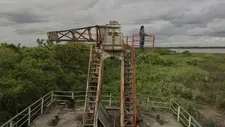 |
| "He is thrown back to himself, to his own loneliness and his own existence." |
AKT: The construction of the journey he takes begins with the cat. You get to the audience on an emotional level, because we do worry about our pets and want to know why the cat is going to the animal hotel. The boat trip he takes after that felt like a mix between The African Queen, a hostage situation because they are blindfolded, and some jungle ride from Disney World. Tell me about what you had in mind for this journey?
In a gray city, Buenos Aires as imagined by Kafka, a man cancels all his services and transports his cat to an animal hotel, before leaving for a trip.
LVR: We tried to play with all those things and layers. The idea of converting the end of times into touristic experience is also related to what is going on on TV. You know, converting near-death experiences into a spectacular for audiences. What just happened in Argentina - two helicopters were going to a [TV] channel camp where they were going to drop international athletes into the desert to survive and they crashed and died, all of them. It's pushing our boundaries because the world gets more and more globalized, so every time we have to go a step further to get a connection maybe to ourselves or to nature.
AKT: That is a good example of fiction no longer being safe. We were taught to think, if it's TV it is safe. Tell me about the work with your actors, or maybe personnel, because many of them are not actors, I suppose. There is hardly any emotional communication but a lot of technical communication.
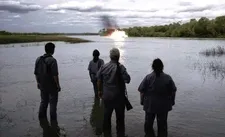 |
| "We really wanted to bring in nature and the world through the sound design." |
LVR: We knew that we wanted to do a film that's very much observant of physical routines and training techniques, not so much focus on words or dialogue and communicate psychological desires or whatsoever from our actors or our characters. During the shooting we started playing with our actors and non-actors trying to find a mood for the film. The main actor, during the first three days of shooting, suddenly came up to me and said "I realise that this guy is really quiet and that he is not going to talk much."
AKT: What is the name of the actor?
LVR: Pablo Seijo [Hernán]. I think it wasn't something political that we decided there wasn't going to be any dialogue. We left it open to what happens in the shooting process. In the process of a team working on an idea, we sort of started to capture the silence. When you are on this journey, you have to trust your gut feeling to go for that. I started thinking halfway into it - it's this very silent, long, distant shots just observing routines, very minimal situations and almost no talking - you start to think, is this going to work as a feature film?
AKT: The sound design is very interesting. Right at the start there is an invisible cow mooing at daybreak. Then a rooster and then you don't know if you hear drums, fireworks, bombs dropping. The sounds speak without dialogue. The effect is not comforting in the least.
LVR: Having a film that is quite silent, we had to and we always wanted to communicate with soundscapes. We really wanted to bring in nature and the world through the sound design. About the opening sequence, you know, animals generally anticipate disaster, so we wanted to make this connection. When this meteor drops in the beginning of the film and you don't know if it's a bomb or a meteor, for me it's a meteor, the animals start to wake up and anticipate the disaster. A metaphor also what is going to happen later in the film. This first shot already condenses some of the ideas in the film.
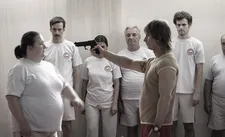 |
| "We wanted to push the clashes in between the elliptical narrations even more." |
AKT: It captures the mood of what is about to come. In the French movie Love At First Fight (Les Combattants) which won 3 Césars, a young woman who is obsessed with the apocalypse and majored in End of the World Studies, attempts to find meaning in military training. Your film features a Book of Disasters that you quote from as chapter headings. The book is your invention, correct?
Thomas Cailley on Madeleine in his film Love At First Fight: "She suffers from real anxiety and this apocalyptic idea of the end of the world. That at the end it will just be this fight for survival and what she has to fight with is only herself, her body."
LVR: No, it's actually a real book.
AKT: Is it Mayan?
LVR: No, I think around 2001, 2002, after the economical crisis in Argentina, this small editorial published this Book Of Disasters. It was really called Manual For The Survival Of The Great Disaster. It's a book that prepares you for several possible ends of the world. From an atomic bomb exploding outside of Buenos Aires to a possible zombie attack.
AKT: New Circumstances, New Rules is one of the chapters you picked. By skipping chapters as well, we don't get any sense of help from this book.
LVR: Exactly. Not really. Each chapter had this recommendation phrase. In the first treatment version of the film's screenplay we had that. It's more literary and it helped us to separate the chapters of the film and then we came back to it in the editing process and incorporated it. We wanted to push the clashes in between the elliptical narrations even more.
AKT: One of the strongest scenes is the shaving of the head. The connections turn even darker at that point. He looks as though he just escaped from a concentration camp. Was that scene in the original script?
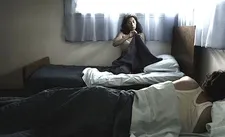 |
| "In the process of a team working on an idea, we sort of started to capture the silence." |
LVR: It was there from the beginning. There was going to be one character that was going to be shattering along the film. Even though you don't see that much of the characters' psychology, like icebergs where you see little peaks, you really have to read it in their actions. That's one of the biggest peaks where you see what's really boiling inside of them. It's this young man's connection with murder and how he shatters morally. He just can't go on with it.
AKT: Talk about your choice of people for the training camp! They could have been picked off a bus somewhere. They are out of shape and not at all what you would expect the participants in such training to look like.
LVR: That was really important to us and it took a really long time, the casting process. We tried to keep them as close to our personal lives as possible. We connected fathers of friends and mothers of friends and grandmothers of friends and tried to incorporate them. First of all we had a very low budget but then also we wanted to have people from the middle class, or the upper Argentinian middle class, who had no experience in physical training whatsoever and then bring them together with real trainers. They are real-life trainers and they do that for a living and we actually developed most of the trainings with them for the film. The actors, or for that matter, non-actors, didn't know what was going to happen, and we just started shooting and put them in context.
AKT: They look happy, as if they're really learning something.
LVR: Yeah, they were really happy. They said "you know, I learned how to shoot guns and how to defend myself!" It was great.
AKT: Which is exactly your point - how easy it is to make people fall for something. That is a bigger political point, too. Maybe the world of consumerism doesn't hold that much allure anymore, but the military training does.
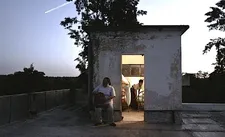 |
| "When you are on this journey, you have to trust your gut feeling to go for that." |
LVR: As soon as, maybe, the basic house of society gets little cracks, this is a real possibility. I don't feel it is very far fetched from things that could actually happen in an instant. People from the upper middle class hiring ex-militaries to tell them how to defend themselves. I think that's definitely real and the scary part was that even during our preparation with the trainees, we felt there was such an extreme violence in these self defense preparations. It was tricky to put theoretical violence that they actually believe in to practice in film. We even had to take trainings out because they seemed like a bizarre fiction.
AKT: Did you have any theory as background for your script. Any theorists who inspired this?
LVR: Not one in particular. A vast, random lecture of war literature, of classic war literature, of Japanese war literature.
AKT: What would be considered classic war literature?
LVR: Clausewitz [Carl von Clausewitz, Prussian general and military theorist] is one of the classic ones. The Art Of War we read, which is a classical philosophy of war [an ancient Chinese military treatise attributed to Sun Tzu]. We read a lot of novels. With Pablo Seijo we read Michel Houellebecq's books to get a connection with his character. With the cinematographer [Roman Kasseroller] we got really inspired by communist propaganda paintings.
AKT: Clausewitz, Houellebecq, communist propaganda…
LVR: It's an odd mixture but it all connects for me esthetically. We saw pictures of communist families in China who wear uniforms like they do in our film. It's this aesthetic of war that we tried to find.
 |
| "When this meteor drops in the beginning…" |
AKT: I thought more of possible non-cinema related connections with your film rather than other filmmakers as inspiration. Is that true?
LVR: A lot of people mention the connection to Austrian cinema like Ulrich Seidl for example. I think there might be a certain aesthetic proximity but maybe it's just a European tradition of filmmaking.
Veronika Franz, co-director of Goodnight Mommy on Parabellum: "Actually, visually, I think his film is very Austrian. I saw the trailer and thought, okay, looks like an Austrian film."
AKT: Is the other comparison you get with Michael Haneke? Because of the violence?
LVR: A little. And because of the coldness.
AKT: You live in Argentina?
LVR: I live in Argentina and I grew up there as a filmmaker. I studied there and was working there. From the people around me, I would say I'm a Latin American filmmaker. But then I come from a definitely European esthetic and background.
AKT: What would you call the most Austrian thing about your film?
LVR: One thing that characterizes Austrian film, or maybe Austrian art in general, is that you try to look at things much rather than look away from things, trying to find social focus points. Trying to find points in society that people don't want to look at. Taking a critical look at the Argentinian upper middle class now.
AKT: The Buenos Aires you show feels really Kafka-esque, the corridors, the grey building with the stairs.
LVR: That is actually a military building. I think it's the Marine building. And we shot the inside scenes in the University of Buenos Aires which has these vast corridors. In the Argentinian media for years now there has been a lot of presence of violence, of fear, of insecurity. I think it also connects an every day political level with what's going on right now. Today so many countries are in crisis and things are changing so much.
AKT: People can clearly connect with it outside of Argentina. Are you working on a next project?
LVR: I get really inspired by locations. I found an almost abandoned nudist swinger club in the province of Buenos Aires.
AKT: That sounds like an Austrian topic.
LVR: And I'm going there, meeting people and start writing there with them. Even more so when I do a documentary start of the project and see where that takes me towards the fictional level.
AKT: You are also doing theater? An opera project in Austria?
LVR: I'm not directing the opera. I'm working for director Christiane Lutz, doing video and animation for the stage. It's an adaptation of The Snow Queen by a Russian composer.
AKT: Based on the Andersen tale, is it for children?
LVR: Yes, it is actually for children and we're doing it at the Palais Esterházy in Eisenstadt [a marvelous baroque palace]. It's going to be quite amazing, I think.





















